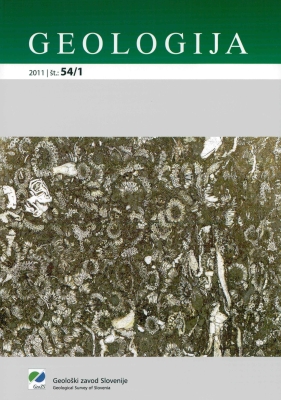Coal in the Mura Formation (Pontian) between Lendava (Slovenia) and Mursko Središće (Croatia), and in the wider area of NE Slovenia
DOI:
https://doi.org/10.5474/geologija.2011.008Abstract
Geological setting, occurrences, extent, quality and reserves of coal seams in the Mura Formation of the Mura- Zala Basin in NE Slovenia are presented in the paper. The Mura-Zala Basin consists of antiforms and sinforms bounded by normal and reverse faults. It is filled in its deepest parts by more than 4000 m of clastic sediments from the late lower Miocene upwards. It represents one of the western basins of the Pannonian Basin System. The coal-bearing Mura Formation is of the Pontian age. It is more than 1000 m thick and consists of marls, silts and sands, and of numerous (10-30) beds of brown coal which are relatively thin. The coal-bearing depositional system is clearly paralic. Original peat-lands developed in freshwater environments while bulk sedimentation in-between (according to paleontological investigations of the Ostracoda microfauna) took place under influence of brackish waters. Well ascertained coal beds are only those in a restricted area (ca. 60 km2) between Lendava (Slovenia) and Mursko Središće (Croatia), where the coal beds dip almost from the surface (under 10-20 m of Quaternary gravel) downwards to depths of not more than 400 m. The whole coal-bearing bed-set in the Lendava area is about 130 m thick but contains only three coal seams which are generally 1.0-2.2 m thick. At the "as received basis" (25-30 % moisture content, 15-20 % ash yield), the net calorific value of the Lendava coal reaches ca. 14.5 MJ/kg, and the average sulphur content is ca. 1.6 %. The Mursko Središće coal is of a similar quality. Tectonic structure of coal beds is simple and uniform. In the Ormož-Selnica Antiform (which continues to the Budafa - Lovászi Antiform in Hungary), strata inclination follows gentle flanks of this antiform and similar is true for other sinforms and antiforms throughout the Mura-Zala Basin. Several very small collieries were in operation in the area of the Ormož-Selnica Antiform between the 1850s and 1970s. The only a little larger was the Mursko Središće colliery, with the highest production of 170,000 tonnes in 1965, and closed in 1972. Coal beds in the broader area of NE Slovenia (ca 1000 km2) are not explored enough. They were encountered by almost all deep oil, gas, and hydrogeological wells but these wells were not core-drilled. The existing data are originating only from master-logs and geophysical logs, by which, coal thicknesses are most probably exaggerated - telling us about thicknesses of single coal beds of 4 metres and even more. Therefore, realistically speaking, if analogy with the Lendava coal-bearing area is taken into consideration, and taking into account that the coal seams thicker than 1 m are in total 5 m thick, than the total coal resources (at the 1.3 t/m3 density) in the entire NE Slovenia amount to around 6500 Mt. In terms of energy, at calorific value of coal of 14.5 MJ/kg, it represents nearly 1014MJ of energy stored.Downloads
How to Cite
Markič, M., Turk, V., Kruk, B., & Šolar, S. V. (2011). Coal in the Mura Formation (Pontian) between Lendava (Slovenia) and Mursko Središće (Croatia), and in the wider area of NE Slovenia. Geologija, 54(1), 97–119. https://doi.org/10.5474/geologija.2011.008
Issue
Section
Articles

